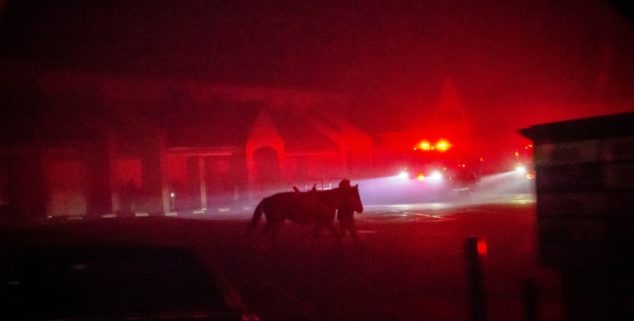News
Outlook bleak for California’s 2019 fire season
 A resident leads horses to safety in Paradise during the 2018 Camp Fire. (Photo: Dylan Mittag, via Shutterstock)
A resident leads horses to safety in Paradise during the 2018 Camp Fire. (Photo: Dylan Mittag, via Shutterstock)Everyone with any knowledge of the subject agrees: California is on the brink of a potentially disastrous fire season. And there is concern that the problem is not going to be solved soon.
“Our best efforts may still be inadequate,” said Michael Picker, president of the California Public Utilities Commission told reporters in June. Forty percent of California is in a fire danger zone, Picker added, and half of the state’s new housing is being built in those danger zones.
Experts say 2018 was the worst wildfire season in state’s history, with nearly 1.9 million acres destroyed and scores of people killed.
“We’re continuing to make the situation worse,” said Picker, whose powerful commission regulates investor-owned utilities in California, including Pacific Gas and Electric Company.
Others agreed.
“How do you tell people not to build? You don’t,” said state Sen. Bill Dodd (D-Napa).
Dodd and Picker were among five panelists appearing before the Sacramento Press Club to discuss the looming danger. Other panelists included Assemblywoman Eloise Gomez Reyes (D-San Bernardino) Southern California Edison Vice President Caroline Choi and Rich Gordon, president of the California Forestry Association.
Several factors have come together to create the potential disaster, panelists agreed: Climate change has produced wetter winters and drier summers; the wet winters have produced heavy vegetation on forest floors; the drier summers have turned that vegetation into fuel ready to become a holocaust given a spark.
Experts say 2018 was the worst wildfire season in state’s history, with nearly 1.9 million acres destroyed and scores of people killed including at least 85 people who died in the Camp Fire that nearly obliterated the town of Paradise.
“I’m not here to proclaim the sky is falling. Instead, I’m here to tell you it will,” Ventura County Fire Chief Mark Lorenzen told the Los Angeles Times last week, emphasizing that the last two fire seasons serve as evidence for what could happen this year.
“As the summer progresses into the fall months, the potential for devastating fire increases until we get rainfall,” Los Angeles County Fire Department Chief Daryl Osby added during a news conference at the Pomona Fairplex.
The PUC said PG&E failed to operate its electrical equipment properly and had “various deficiencies” in its tree-trimming program.
The Sacramento panel discussion occurred almost simultaneously with news that PG&E agreed to pay $1 billion to 14 local governments to cover damages from wildfires caused by its downed power lines. The settlement must still be approved by a bankruptcy court.
The giant utility — it serves some 5.4 million electricity customers and 4.3 million gas accounts — is also facing potential damages of more than $30 billion in lawsuits filed by local governments, insurance companies and private property owners.
The October 2017 wine country fires, which killed 44 people, destroyed nearly 9,000 buildings and burned 245,000 acres. In an order released late Thursday, the PUC said that PG&E failed to operate its electrical equipment properly and had “various deficiencies” in its tree-trimming program, contributing to the 2017 fires.
PG&E, in bankruptcy and with 300,000 miles of potentially dangerous power lines, took a beating from the panelists.
“We have to place the majority of the blame exactly where it belongs – and that’s PG&E,” Reyes said. “San Diego has been a good player. PG&E has not,” she added.
“We’re in a different position than PG&E, and we certainly want to stay out of that situation,” Choi said.
“We have a big fucking fire problem in California.” — Michael Picker
Should PG&E be broken up?
Picker pointed out that a big utility such as PG&E has the heft to deal with major crises, while a flotilla of smaller utilities would not have as many resources.
What about lessening the fire danger by thinning out the forests, removing underbrush and excess trees?
What do you do with all that material? Gordon asked.
“There are 30 timber companies left in California, and only 27 operating sawmills left and they’re all at capacity,” he said.
In addition, 60 percent of California forests are under federal control, meaning that any thinning operation would involve negotiations with Washington.
The fire danger means “There may be a reshuffling of everything people know,” Picker said.
“We have a big fucking fire problem in California,” he added.
Want to see more stories like this? Sign up for The Roundup, the free daily newsletter about California politics from the editors of Capitol Weekly. Stay up to date on the news you need to know.
Sign up below, then look for a confirmation email in your inbox.

Leave a Reply